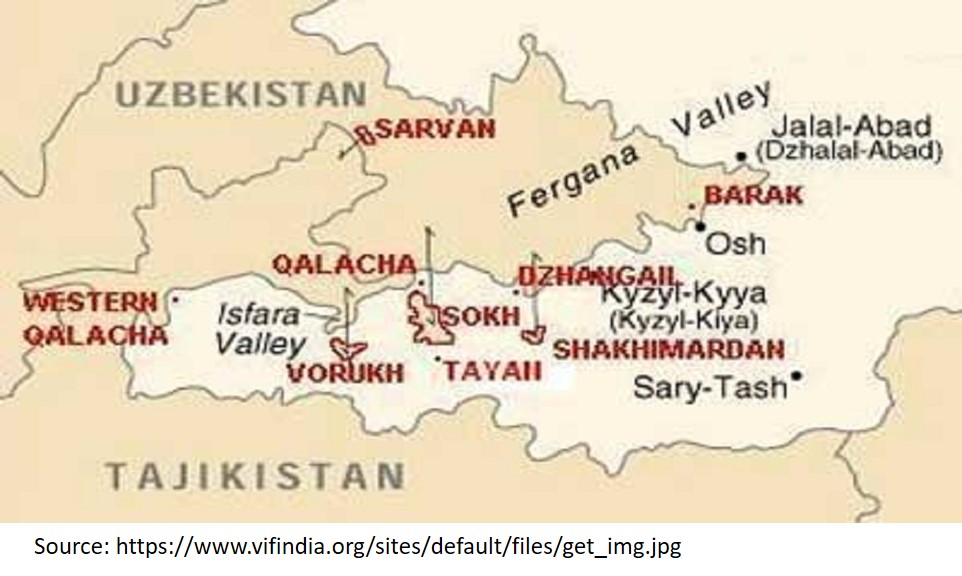Background
On September 14, border guards from Kyrgyzstan and Tajikistan exchanged fire at a disputed border section. The violent confrontation escalated and lasted for two days, with drones, tanks, aircraft, and exchange of rocket fire. In the bloodiest violence in years, at least 94 people were killed, and more than 100 were injured. Around 137,000 people have been evacuated from the disputed section of the border in Kyrgyzstan’s Batken and Osh regions due to the violence. There were no reports of evacuation from the Tajik Side. Both countries have accused each other of aggression.[1]
The Kyrgyz side reported that the Tajik forces shelled the Kyrgyz border villages of Kulundu, Maksat, and Jani-Jer, and that advanced weaponry and equipment were used. After clashes with Tajikistan border guards, Kyrgyzstan announced a state of emergency in the Batken region.[2] On the other hand, the Tajik officials said that Kyrgyz soldiers had destroyed a mosque and were attacking civilian property, including residential properties. Tajikistan’s Security services also said that Kyrgyzstan was gathering military forces and supplies close to the border in preparation for provocations.[3]
What sparked the violence on the sensitive border between the two former Soviet neighbours in Central Asia was not immediately known. The two nations agreed to form a committee to address the border dispute, as cease-fire breaches occur regularly. Not only that but the allegations and counterclaims made by both governments exacerbate the problem.
The Soviet border delimitation of the 1920s, which intended to divide Central Asian administrative boundaries along ethnic lines, proved flawed in the Post-Soviet period. The Ferghana Valley, an area with a large population and fertile land that Uzbekistan, Kyrgyzstan, and Tajikistan share, has been in a permanent state of strife due to the overlap of ethnic groups.[4] This resource-rich Valley, which must be shared equally by overlapping ethnic groups in border areas, has seen several deadly inter-ethnic confrontations. The issue of enclaves and exclaves amongst the three Central Asian republics that share the Valley has been the main source of tension.[5]
The region has a long history of conflict for resource access. Allocation of land, water, and pasture was a source of contention between republics and administrative divisions throughout the Soviet era. These conflicts only grew following the breakup of the Soviet Union in 1991. While the boundary between Kyrgyzstan and Tajikistan is more than 970 kilometres long, according to government data, just 504 kilometres have been demarcated.[6] Social tensions are frequent, especially in the northern Tajik region of Isfara and in Vorukh, a Tajik exclave with a 30,000 population in Kyrgyzstan’s Batken Province bordering Tajikistan’s Sughd Province. Additionally, legalizing of private property ownership and proclamation of certain rented Tajik pastures by Kyrgyzstan further aggravated the tensions.[7]

Implications
As mentioned earlier, land and water usage issues have been more prominent in conflicts between the two nations during the past ten years. More than 150 incidents of tensions and clashes between them were documented during this time, including heavy casualties as a result of the causes mentioned above. The last deadly clash, which erupted in April 2021, killed at least 55 people, 36 in Kyrgyzstan and 19 in Tajikistan. The reason behind the clash was to gain control of the Golovnoy water distribution network located on the Kyrgyz-Tajik border. [8]
On September 16, the presidents of both countries met on the sidelines of the 22nd Summit of the Shanghai cooperation organization (SCO) in Samarkand, Uzbekistan. During their meeting, the two heads of state discussed the situation on the Tajik-Kyrgyz border. The statement published on Tajik President’s Website reads, “the Presidents agreed to establish a commission to investigate the causes of the armed incident and instructed the co-chairs of the Intergovernmental Commission on the Delimitation and Demarcation of the State Border to intensify its work, including the activities of working groups on topographic and legal issues. The heads of state were unanimous in their opinion that all emerging issues should be resolved exclusively by political and diplomatic means”.[9]
This is not the first time the two presidents have met and discussed border issues, but conversations have occurred several times and at various levels, with no tangible solutions. There are a few factors to examine while determining the causes of an unsolved border dispute between these two countries:-
Tajik President Emomali Rahmon is the only Soviet-era leader in Central Asia whose authority is centered on fostering Tajik nationalism. Tajikistan’s border conflict with Kyrgyzstan may also be viewed through the prism of Tajik nationalism. If Tajikistan resolves border disputes with Kyrgyzstan, this may be considered as jeopardising Tajikistan’s geographical integrity. As a result, any realistic solution to this situation has been delayed for so long. President Rahmon also intends to hand over power to his son in coming years. As a result, any concession on Tajik territorial integrity may go against his intentions.
Kyrgyzstan, the only post-Soviet Central Asian country practicing democracy, has been exposed to recurring colour revolutions. Sadyr Japarov, a populist leader, was elected President in the most recent revolution. He has several obstacles in order to stabilise the country’s domestic situation. The border problem with Tajikistan poses significant challenges to his regime. Although he has pushed for resolving the issue via dialogue and discussion, as well as adhering to international rules, one of his main focuses has been to enhance armed capabilities. However, barely a day before the current conflict, President Japarov opened the base of Unmanned Aerial Vehicles (UAVs) of the Border Guard Service. Speaking to the border guards, he stated that “ensuring Kyrgyzstan’s border security is regarded one of the state’s priorities. We are accountable for taking any and all steps necessary to strengthen the capability of our border guards.”[10] Kyrgyzstan recently purchased Turkish drones, which the Tajik side alleged were used in the border conflict with Tajikistan.[11]
This border dispute has severe implications for Central Asia’s growing regional cooperation. Following the passing of Islam Karimov, the New Uzbek President Mirziyoyev has been at the forefront of a constructive campaign to promote regional cooperation and dialogue amongst the Central Asian authorities. Uzbekistan’s border issues with Tajikistan and Kyrgyzstan have also been resolved. As a result of the favourable regional climate, intra-regional trade, commerce, and transportation activities have grown. Territorial disputes between Tajikistan and Kyrgyzstan will hamper this progress.
The conflict also has implications for Central Asian regional security. Fundamentalist groups might use any sensitive situation in the region to expand their influence. Central Asia is already vulnerable to the threat of Islamic State (ISIS) and developments in Afghanistan. As a result, border clashes may provide another opportunity for radical organizations to push their agendas.
Conclusion
People who live near the border regions have suffered the most because of the ongoing border dispute between Kyrgyzstan and Tajikistan. The socio-economic impact of such incidents is enormous and occasionally difficult to repair. The leaders of both nations must act quickly to find a workable solution to this problem, putting aside personal interests. Regional and international players must also step forward to assist them in resolving this situation. In this context, Russia has a significant role to play. Moscow needs to take the initiative to bring the two presidents to an understanding on resolving the territorial issues since it has military bases in both nations, and Kyrgyzstan is a member of the CSTO, which Russia leads. Resolving the border issues at the earliest should also be an issue of the discussion at the next consultative meeting of the Heads of the Central Asian states.
Endnotes :
[1]Alys Davies, “Kyrgyzstan-Tajikistan border clashes claim nearly 100 lives” BBC News, September 20, 2022. https://www.bbc.com/news/world-asia-62950787
[2]Nazir Aliyev, “Kyrgyzstan, Tajikistan border disputes continue for 31 years”, September, 17, 2022. https://www.aa.com.tr/en/asia-pacific/kyrgyzstan-tajikistan-border-disputes-continue-for-31-years/2687807#:~:text=Almost%20half%20of%202%20countries'%20borders%20are%20'disputed'&text=While%20only%20503%20kilometers%20(312.5,have%20been%20ongoing%20since%202012
[3]Ibid.
[4]P K Gupta, “Recurring Clashes on Tajik-Kyrgyz Border over Raising of National Flags”, VIF Article, July 29, 2019. https://www.vifindia.org/2019/july/25/recurring-clashes-on-tajik-kyrgyz-border-over-raising-of-national-flags
[5]Ibid.
[6] “What drove the worst Kyrgyz-Tajik conflict in years?, The Thirdpole, May 28, 2021. https://www.thethirdpole.net/en/regional-cooperation/climate-nationalism-unresolved-borders-and-the-pandemic-drove-kyrgyz-tajik-conflict/
[7]Kurmanalieva, Gulzana. « Kyrgyzstan and Tajikistan: Endless Border Conflicts », L'Europe en Formation, vol. 385, no. 1, 2018, pp. 121-130. https://www.cairn.info/revue-l-europe-en-formation-2018-1-page-121.htm?contenu=citepar
[8]Nazir Aliyev, “Kyrgyzstan, Tajikistan border disputes continue for 31 years”, September, 17, 2022. https://www.aa.com.tr/en/asia-pacific/kyrgyzstan-tajikistan-border-disputes-continue-for-31-years/2687807#:~:text=Almost%20half%20of%202%20countries'%20borders%20are%20'disputed'&text=While%20only%20503%20kilometers%20(312.5,have%20been%20ongoing%20since%202012
[9] “Meeting with President of the Kyrgyz Republic Sadyr Japarov”, Tajik President Website, September, 17, 2022. https://mfa.tj/en/newdelhi/view/11021/meeting-with-president-of-the-kyrgyz-republic-sadyr-japarov
[10]President Sadyr Japarov opened the base of UAVs of the Border Guard Service, September 13, 2022. http://www.president.kg/kg/okujalar/zhanylyktar/23311_prezident_sadir_ghaparov_ukmk_chek_ara_kizmatinin_uchkuchsuz_uchuuchu_apparattarinin_bazasin_achti
[11] “Tajikistan accuses Kyrgyzstan of hiding military hardware near border” The Reuters, September 21, 2022. https://www.reuters.com/world/asia-pacific/tajikistan-accuses-kyrgyzstan-hiding-military-hardware-near-border-2022-09-21/
(The paper is the author’s individual scholastic articulation. The author certifies that the article/paper is original in content, unpublished and it has not been submitted for publication/web upload elsewhere, and that the facts and figures quoted are duly referenced, as needed, and are believed to be correct). (The paper does not necessarily represent the organisational stance... More >>
Image Source: https://static.ca-news.org/upload/ennews/3/632763.1579144626.b.jpg










Post new comment